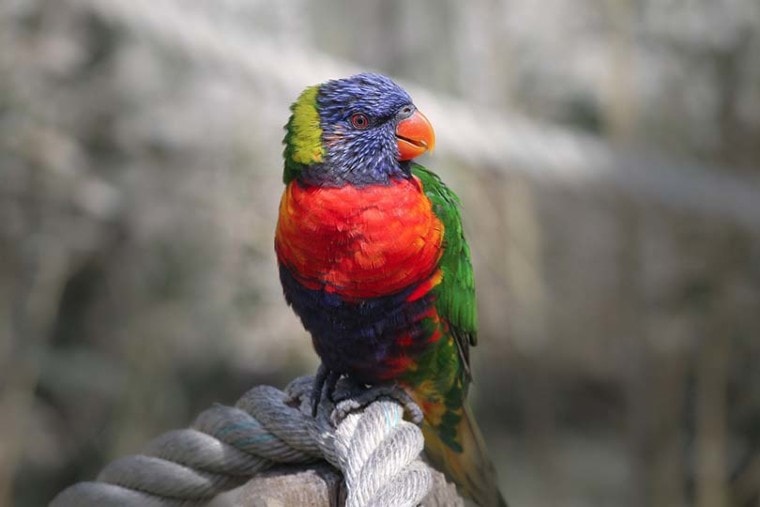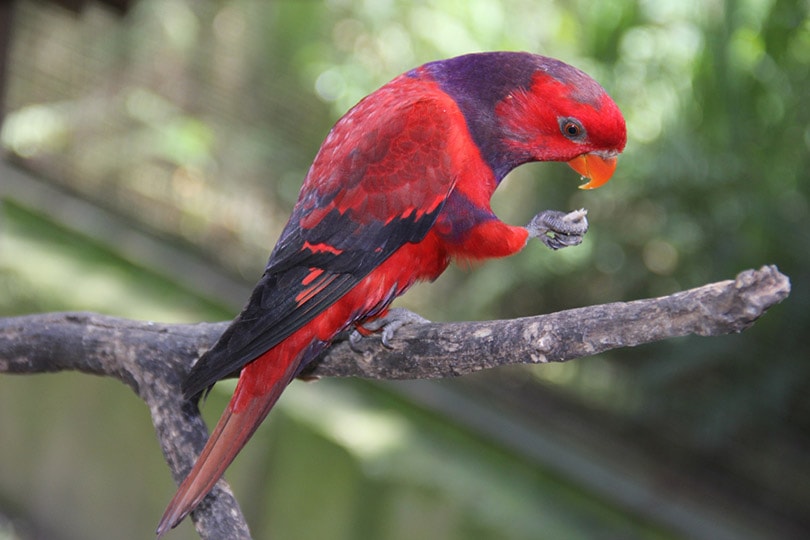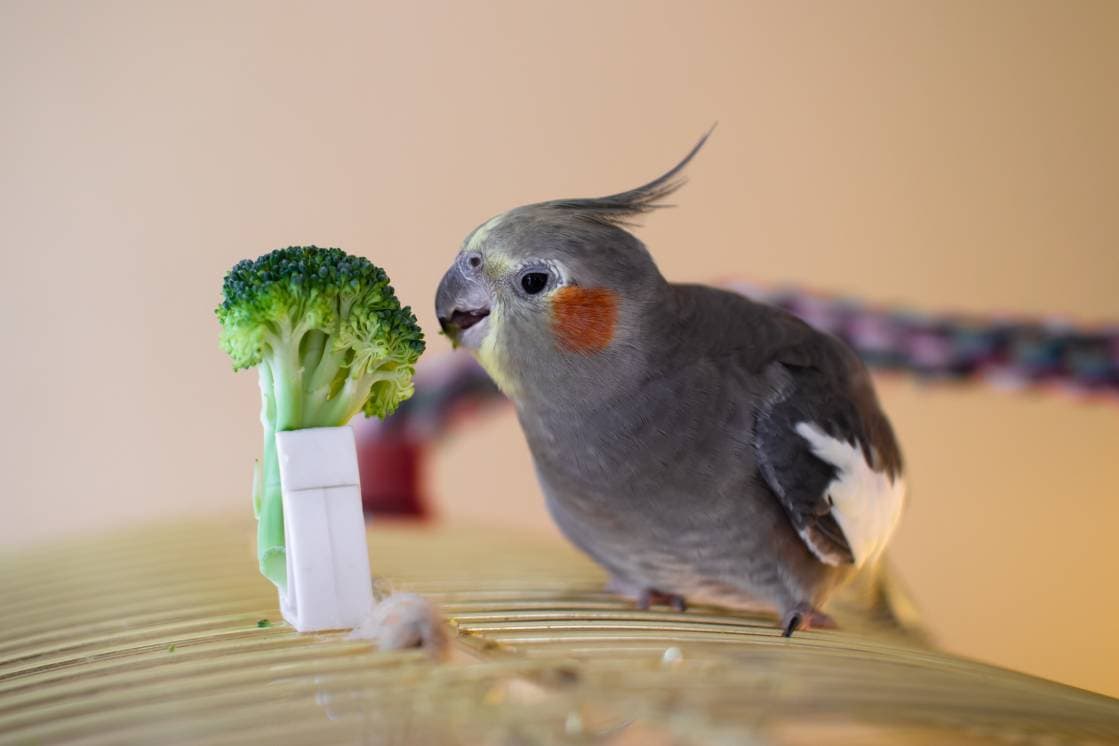
There are over 50 known species of lorikeets, although most are not commonly kept as pets. Those that do make good pets, however, span the breadth of lorikeet colors and sizes. If you are a fan of pet birds and are interested in learning more about lorikeets, we’ve put together this list of the types of lorikeets that are good pets. Keep reading to learn more about them!

The Lorikeet
Lorikeets are a member of the parrot family. They are typically small or medium-sized birds and live primarily in tree-filled areas of Australia, Southeastern Asia, and the surrounding islands. Most lorikeets have brightly colored feathers, making them brilliantly beautiful birds.
Lorikeets differ from other parrot species in their dietary needs. These birds feed primarily on pollen and nectar from plants. They also occasionally eat fruits, insects, and berries. They are not able to eat seeds, however, as their gizzards don’t grind seeds as many other birds do.
Not all species of lorikeets should be kept in captivity, especially as pets. Some are known to bite while others don’t thrive unless they are free to roam as they please. Others have found themselves on the endangered species list because of the heavy destruction of their habitats and capture for the pet trade.
The 12 Types of Lorikeets that Make Great Pets
1. Black Lory

| Size: | 12 to 13 inches |
| Habitat: | Indonesia, New Guinea |
| Temperament: | Gentle, noisy, attention-loving |
The black lory has nearly all-black feathers, making them less colorful than some of the other lorikeet species. They do have some red and yellow feathers under their tails. The black lory is one of the gentlest of lorikeets, making it a good choice as a pet. They are known to be noisy, especially when they feel like they aren’t getting enough attention.
2. Black-Capped Lory

| Size: | 12 inches |
| Habitat: | New Guinea and surrounding islands |
| Temperament: | Smart, energetic, noisy, social |
The black-capped lory is very colorful. They have blue, red, and purple bodies with green wings and yellow tails. Their name comes from the black cap-like feathers on top of their heads. Their beaks are bright orange and their feet are grey. As pets, the black-capped lory needs plenty of social interaction. They are very intelligent and can learn to mimic many sounds.
3. Black-Winged Lory

| Size: | 12 inches |
| Habitat: | Indonesia |
| Temperament: | Friendly, social |
The black-winged lory has a primarily bright red body with black markings on the wings and near the legs. They have a bright blue patch on their cheeks, leading to their other common name, the blue-cheeked lory. This species has been over-captured in the wild and much of their habitat has been destroyed. Because of this, efforts are being made to protect them in the wild and to breed and release them. To help rebuild their numbers in the wild, it’s not recommended that the black-winged lory be kept as a pet.
4. Blue-Streaked Lory

| Size: | 12 inches |
| Habitat: | Tanimbar and Barbar |
| Temperament: | Social, friendly, playful |
The blue-streaked lory has a bright red body with black patches on the wings. They have bright blue streaks on their necks and a black patch over each eye. These birds are active and playful. Unfortunately, over-capturing for the exotic pet trade, paired with habitat destruction has made them endangered and quite rare. The best use of the breeding of these birds is for repopulation in the wild.
5. Cardinal Lory

| Size: | 12 inches |
| Habitat: | Solomon Islands |
| Temperament: | Friendly, energetic, playful |
The cardinal lory has bright red feathers covering most of its body. They have some black feathers on their wings and tails. Their beaks are orange and they have a grey band around their eyes. This species is less frequently kept as pets than some of the others. However, they are very intelligent and playful. Their call is quite loud and screechy, perhaps contributing to the less popular status as a pet.
6. Duivenbode’s Lory

| Size: | 10 to 11 inches |
| Habitat: | New Guinea, Indonesia |
| Temperament: | Active, noisy, social |
Duivenbode’s lory, also called the brown lory, is dark brown with a bright yellow ring around the head. They also have some yellow feathers on their wings, neck, and legs. Of all the species of parrots, this is the only one that has a brown and yellow color scheme. They are less common as pets, although the Duivenbode’s lory is thought to have stable numbers in the wild.
7. Edward’s Lory

| Size: | 10 to 11 inches |
| Habitat: | Timor Islands, Indonesia |
| Temperament: | Curious, playful, social |
Edward’s lory is also known as the Marigold lory. Their main feather color is green, but they also have blue streaks on their head, face, and cheeks. They have yellow feathers on their chest and a yellow-green band on their necks. Their beaks are bright orange. As pets, Edward’s lories can learn to speak and are otherwise quieter than some of the other lorikeet species.
8. Rainbow Lory

| Size: | 12 to 15 inches |
| Habitat: | Australia |
| Temperament: | Sweet, friendly, social |
The species of lorikeet most commonly found in households is the rainbow lory. These birds are beautiful with blue, green, red, yellow, and orange patches of feathers on their bodies. They have bright red beaks and black feet. Along with their beautiful appearance, the rainbow lory is known for being very sweet and affectionate. They enjoy people and love attention.
9. Red Lory

| Size: | 10 to 12 inches |
| Habitat: | Australia, Indonesia |
| Temperament: | Curious, affectionate, intelligent |
The red lory has bright red feathers covering most of its body. The tips of its wings are black and there are blue feathers on the wing and under the tail. As pets, these birds like to make noise. They are chatty and social, craving your attention constantly. The red lory is also very intelligent and loves to play with toys.
10. Violet-Necked Lory

| Size: | 11 inches |
| Habitat: | Indonesia |
| Temperament: | Playful, intelligent, social |
The violet-necked lory has a primarily red body with violet bands of feathers around their necks and violet feathers on their bellies. They have black feathers on their wings and bright orange beaks. These birds are popular pets due to their sparkling personalities and high levels of intelligence. However, they are now endangered in the wild. All breeding efforts are being focused on returning these beautiful birds to their natural habitats rather than breeding them for the pet trade.
11. Yellow-Backed Chattering Lory

| Size: | 12 inches |
| Habitat: | Maluku group of islands |
| Temperament: | Intelligent, mischievous, chatty |
The yellow-backed chattering lory is primarily red with green, yellow, and black feathers on their wings and green feathers on their legs. They have a bright yellow patch on their back, hence the name. This is another species of lorikeet that is now endangered due to habitat destruction and the pet trade. Like the others, it is not recommended that they be bred as pets now but rather bred for release into the wild.
12. Yellow-Streaked Lory

| Size: | 12 inches |
| Habitat: | New Guinea, Indonesia |
| Temperament: | Noisy, curious, social |
The yellow-streaked lory has bright and light green feathers over most of its body. Their heads are bright red and black. They also have yellow spots or streaks on their chests and around their neck. They are less commonly kept as pets than some of the others on this list. This is likely due to their tendency to call out loudly.

Conclusion
Lorikeets come in a wide range of colors. Some species, like the rainbow lory, are commonly kept as pets. Others, like the violet-necked lory, have seen their numbers decimated in the wild due to habitat destruction and capture for the pet trade.
If you plan to keep a lorikeet as a pet, make sure you are only getting your bird from a reputable breeder. You should also stick to the species that are thriving in the wild and aren’t on the endangered species list.
Featured Image Credit: manfredrichter, Pixabay







